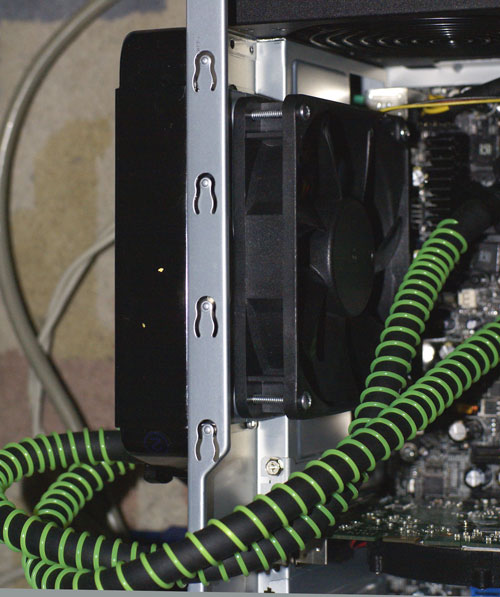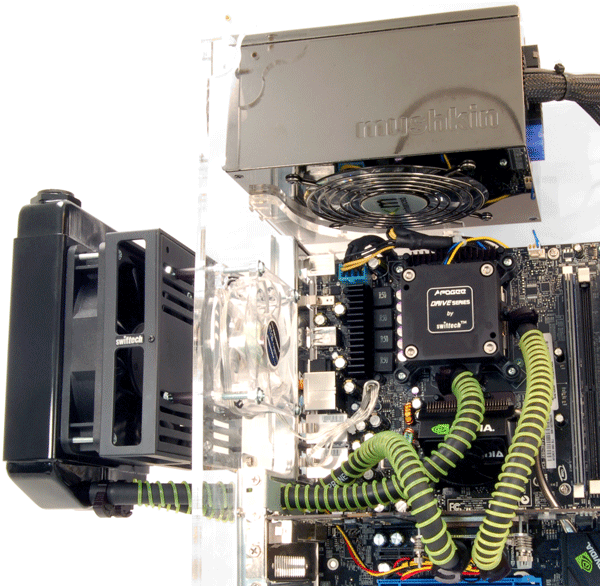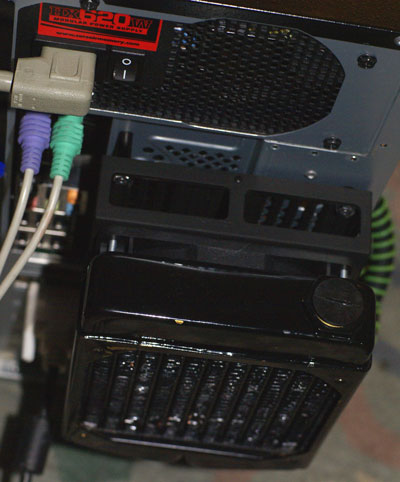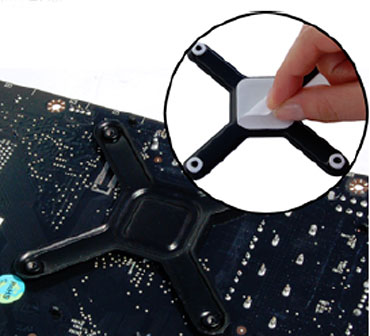Swiftech H2O-120 Compact and Corsair Nautilus 500: Is Water Better?
by Wesley Fink on September 17, 2007 6:00 AM EST- Posted in
- Cases/Cooling/PSUs
Swiftech H2O-120 Compact
Swiftech specializes in cooling for the enthusiast market. It is probably best known for its liquid cooling solutions, but Swiftech began with air cooling and has also had a few air coolers that were very well-known, like their ongoing MC and MCX air coolers for AMD and Intel. Swiftech also markets thermoelectric cooling parts, specialty ram and MOSFET coolers, and even a specially modified Antec P180 case called the QPower P180 for water cooling.
The Company was founded in 1994 by Gabriel Rouchon, incorporated in 2001, and was first publicly traded in 2005. Though there have been many changes in the company's structure over the years, it is worth mentioning that Gabe Rouchon is still very active in Swiftech, and Gabe often works directly with reviewers on tweaking the company's cooling products.
Swiftech markets both individual cooling products such as CPU water blocks, chipset and VGA water blocks, pumps, radiators, reservoirs, and cooling accessories. They also market complete water cooling kits such as the H2O-220 Apex Ultra and the H2O-80 Micro. Their newest kit, the H2O-120 Compact is the subject of this review.

The complete H2O-120 Compact kit comes packaged in a small box measuring roughly 13x7x4 inches. Everything needed for a standard Intel or AMD installation is included in the package.

The radiator/reservoir and water block/pump are well protected by the cutouts in the rigid foam block. Components are located on both the top and bottom of the Styrofoam. If you can't find the funnel it's mounted on the bottom.

You can see how much Swiftech has simplified this water cooling system by looking at the small number of parts compared to traditional water cooling kits. The fan/radiator/reservoir is basically one module, and the water block/pump is the second module. These two components are connected by pre-cut 10" Neoprene 3/8" tubes. All of the hardware for mounting is included, such as the mounting screws, Intel backplate (shipped attached to the Apogee Drive Block), a 7V electrical connector for running the fan at low speed, Arctic Silver Ceramic thermal grease, and the water additive. An alternate mounting block is also included for AMD/AM2 processor mounting.
Swiftech does not include the distilled water required for filling the system. Specialty cooling etailers and scientific equipment shops carry this; however, the most readily available source for distilled water we found is Wal-Mart, where a gallon of distilled water was less than a buck. The coolant additive is mixed with a half liter (pint or 16 oz.) of distilled water.
Installation

The kit mounts just fine in a full tower case, and it will mount fine in an Antec P180 which mounts the power supply at the bottom of the mid-tower case. The kit as supplied did fit any bottom-mount mid-tower case available for testing. However, the Swiftech H2O-120 Compact kit would not fit any top-mount power supply mid-tower case we tried. This included about six different brands of the most common top-mount PSU cases, either premium or value brands. The radiator is about a half inch too long to mount in top PSU mid-tower cases. Those equipped with 120mm exhaust fans all had screw holes that would not allow mounting of the radiator.
Both our old and new cooling test beds are top PSU mid-tower cases, and the H2O-120 Compact would not fit either case as supplied. We used that configuration because this is the case design readers most often own - it is the most common case available and accounts for the most sales. To be fair to other solutions, it was possible to find a way to install the H2O-120 Compact in the test bed case, so we could advise readers of what was needed to mount in this common design.

The easiest mount was a split design, where the radiator was mounted outside the case and the fan is inside the case. To use this mount you will need longer screws in some mid-tower cases and a longer pair of hoses. We found the 12" length worked fine in our case, and extra hoses are available from Swiftech.

When there is not enough room for the radiator, Swiftech recommends using their "Radbox" for external mounting.

You will also need longer tubing for the Radbox install, but all the necessary screws and washers come with the Radbox from Swiftech. The Radbox kit even includes a PCI slot cover for running tubing to the outside of the case for external radiator mounting.
Performance tests were run with both the split-install configuration and the recommended Radbox external configuration. Cooling results were all but identical; the recommended external install was 0C to 2C cooler at most speeds. If your 120mm grill is not perforated enough you may have to remove the fan circle for best cooling, but the kit cooled fine on our test bed with the perforated 120mm grill intact.

Once you have determined fit and decided on how you will mount the H2O-120 Compact you will need to assemble and leak test the water cooling system. The Intel 775 block requires a back plate so you will have to remove the motherboard to install the water cooling system. It was easiest for us to stick or tape the back plate to the motherboard and remount it for final install, because we strongly advise testing for leaks before mounting the system over the motherboard.

In a standard install everything is inside so you can attach the tubes, fill the system and operate the pump away from the computer. The manual includes information on how to run the power supply to test the system, before it is installed on the motherboard.

On the installs with the radiator outside the case you will have to plan assembly and water testing, since the water system should be filled after the tubes are passed through the PCI slot. The tubes for external mount were long enough that the Apogee block could dangle from inside the case to the outside for filling and leak testing. The apogee block was dangled over the back on a dry cloth for leak-testing where the tubing needed to pass though the PCI bracket.
The bottom line on installation is that the standard install is relatively simple, and it is definitely much simpler than the traditional four component water cooling systems. If you are a first-time water cooling installer and the system fits your case, 30 minutes is probably a reasonable time to install. However, if you are installing in a top PSU mid-tower case you will need to buy or order parts, carefully plan your install, and it will take an hour or more to install the system once your parts arrive. The penalty for a sloppy install without leak testing could be a dead motherboard and CPU, so we strongly recommend that you take your time and use the precautions necessary to assure you have a leak-proof water system.
Swiftech specializes in cooling for the enthusiast market. It is probably best known for its liquid cooling solutions, but Swiftech began with air cooling and has also had a few air coolers that were very well-known, like their ongoing MC and MCX air coolers for AMD and Intel. Swiftech also markets thermoelectric cooling parts, specialty ram and MOSFET coolers, and even a specially modified Antec P180 case called the QPower P180 for water cooling.
The Company was founded in 1994 by Gabriel Rouchon, incorporated in 2001, and was first publicly traded in 2005. Though there have been many changes in the company's structure over the years, it is worth mentioning that Gabe Rouchon is still very active in Swiftech, and Gabe often works directly with reviewers on tweaking the company's cooling products.
Swiftech markets both individual cooling products such as CPU water blocks, chipset and VGA water blocks, pumps, radiators, reservoirs, and cooling accessories. They also market complete water cooling kits such as the H2O-220 Apex Ultra and the H2O-80 Micro. Their newest kit, the H2O-120 Compact is the subject of this review.

The complete H2O-120 Compact kit comes packaged in a small box measuring roughly 13x7x4 inches. Everything needed for a standard Intel or AMD installation is included in the package.

The radiator/reservoir and water block/pump are well protected by the cutouts in the rigid foam block. Components are located on both the top and bottom of the Styrofoam. If you can't find the funnel it's mounted on the bottom.

You can see how much Swiftech has simplified this water cooling system by looking at the small number of parts compared to traditional water cooling kits. The fan/radiator/reservoir is basically one module, and the water block/pump is the second module. These two components are connected by pre-cut 10" Neoprene 3/8" tubes. All of the hardware for mounting is included, such as the mounting screws, Intel backplate (shipped attached to the Apogee Drive Block), a 7V electrical connector for running the fan at low speed, Arctic Silver Ceramic thermal grease, and the water additive. An alternate mounting block is also included for AMD/AM2 processor mounting.
Swiftech does not include the distilled water required for filling the system. Specialty cooling etailers and scientific equipment shops carry this; however, the most readily available source for distilled water we found is Wal-Mart, where a gallon of distilled water was less than a buck. The coolant additive is mixed with a half liter (pint or 16 oz.) of distilled water.
Installation

The kit mounts just fine in a full tower case, and it will mount fine in an Antec P180 which mounts the power supply at the bottom of the mid-tower case. The kit as supplied did fit any bottom-mount mid-tower case available for testing. However, the Swiftech H2O-120 Compact kit would not fit any top-mount power supply mid-tower case we tried. This included about six different brands of the most common top-mount PSU cases, either premium or value brands. The radiator is about a half inch too long to mount in top PSU mid-tower cases. Those equipped with 120mm exhaust fans all had screw holes that would not allow mounting of the radiator.
Both our old and new cooling test beds are top PSU mid-tower cases, and the H2O-120 Compact would not fit either case as supplied. We used that configuration because this is the case design readers most often own - it is the most common case available and accounts for the most sales. To be fair to other solutions, it was possible to find a way to install the H2O-120 Compact in the test bed case, so we could advise readers of what was needed to mount in this common design.

The easiest mount was a split design, where the radiator was mounted outside the case and the fan is inside the case. To use this mount you will need longer screws in some mid-tower cases and a longer pair of hoses. We found the 12" length worked fine in our case, and extra hoses are available from Swiftech.

When there is not enough room for the radiator, Swiftech recommends using their "Radbox" for external mounting.

You will also need longer tubing for the Radbox install, but all the necessary screws and washers come with the Radbox from Swiftech. The Radbox kit even includes a PCI slot cover for running tubing to the outside of the case for external radiator mounting.
Performance tests were run with both the split-install configuration and the recommended Radbox external configuration. Cooling results were all but identical; the recommended external install was 0C to 2C cooler at most speeds. If your 120mm grill is not perforated enough you may have to remove the fan circle for best cooling, but the kit cooled fine on our test bed with the perforated 120mm grill intact.

Once you have determined fit and decided on how you will mount the H2O-120 Compact you will need to assemble and leak test the water cooling system. The Intel 775 block requires a back plate so you will have to remove the motherboard to install the water cooling system. It was easiest for us to stick or tape the back plate to the motherboard and remount it for final install, because we strongly advise testing for leaks before mounting the system over the motherboard.

In a standard install everything is inside so you can attach the tubes, fill the system and operate the pump away from the computer. The manual includes information on how to run the power supply to test the system, before it is installed on the motherboard.

On the installs with the radiator outside the case you will have to plan assembly and water testing, since the water system should be filled after the tubes are passed through the PCI slot. The tubes for external mount were long enough that the Apogee block could dangle from inside the case to the outside for filling and leak testing. The apogee block was dangled over the back on a dry cloth for leak-testing where the tubing needed to pass though the PCI bracket.
The bottom line on installation is that the standard install is relatively simple, and it is definitely much simpler than the traditional four component water cooling systems. If you are a first-time water cooling installer and the system fits your case, 30 minutes is probably a reasonable time to install. However, if you are installing in a top PSU mid-tower case you will need to buy or order parts, carefully plan your install, and it will take an hour or more to install the system once your parts arrive. The penalty for a sloppy install without leak testing could be a dead motherboard and CPU, so we strongly recommend that you take your time and use the precautions necessary to assure you have a leak-proof water system.










58 Comments
View All Comments
psychotix11 - Monday, September 17, 2007 - link
But water cooling has never been about the best price for the buck. The same can be said of any high end parts. Extreme intel, amd FX, 8800gtx, SLI, none of this makes sense for the price you pay.Water cooling falls right into that category. If you really want it to show it's teeth load up an 8800 SLI system, build a custom loop at the 300 and 500 price point, water cool everything, and then compare temps.
Obviously it's going to cost a lot more, but this is a given.
You're article seems to hint that air cooling is better then water cooling, this isn't the case at all. All it shows is that high end air cooling is a better value then a water cooling kit designed for a novice on a budget.
As for "might" and 300, that's wrong as well. My apogee gt + lian DDC, + mcr 220 2x yate loons push, pentosion did drop my temps over a tuniqu tower. The water blocks on the 8800's with an mcr 320 moved even more hot air out of my case and temps dropped more. That CPU loop costs less then 300.
So, DDC pump $65, mcr 220 45, apogee gt 45, and about 30 bucks for fans, tubing and anti corrosive. Brings you to about 200, hardly the 300.
EODetroit - Monday, September 17, 2007 - link
Next time water cool the video card as well, and compare it against the CPU and video card on Air. OC both the video card and CPU and see how far they go. Then measure system noise. I agree with your conclusion that if you're only going to water cool your CPU, that you might as well go with a new air cool instead. But the CPU isn't the only expensive, hot, noisy thing in the case. In fact, the GPU is for many or most of us more expensive, hotter, and noisier.You shouldn't pretend the GPU isn't there. Water cool it as well and compare it THEN against air cooling.
Lonyo - Monday, September 17, 2007 - link
You forgot another element of one of your watercooling setups.It's external.
PLEASE PLEASE PLEASE try looking at other temperatures, e.g. graphics card, motherboard, HDD, when doing these tests.
The heat has to go somewhere. With an air cooler it stays inside the case before passing by the graphics card and getting pushed out the back of the case.
With an external watercooling setup it gets transferred outside without going over the graphics card/motherboard, and hence internally other components beside the CPU should in theory be cooler.
My view is that the main advantage of watercooling is the low CPU temps combined with lower internal case temps, since I wouldn't think of running water with an internal radiator.
Nickel020 - Monday, September 17, 2007 - link
I don't understand how you reached the conclusion, that good air cooling is better than sub 300$ water cooling by testing two sub 150$ water cooling kits.I have recently upgrade from a lapped Scythe Infinity to a 300$ wattercooling setup and at a maximum fan speed of ~1300 rpm (two fans dual radiator) the watercooling beats air by 10K but is little bit noisier since the fans sit at the top of the case. At 7V it's less noisier than the Infinity and still about 5K cooler.
Please test a real 200+$ watercooling setup before drawing such conclusions. The test clearly shows that cheapw atercooling isn't worth it, but starting at about 200$ watercooling will beat air cooling if you choose good components.
Here's a link to jstu about the ebst setup for 250$:
http://www.petrastechshop.com/pecoel.html">http://www.petrastechshop.com/pecoel.html
The waterblock is one of the ebst available, the Swiftech radiators are great for the price and with a modded top the Laing pupm is very quiet and has a excellent performance.
I'd very much like to see Anandtech finally review some proper water cooling!
PS: The review is otherwise very nice, finally a good review that compares low end watercooling with top-end air cooling.
poohbear - Monday, September 17, 2007 - link
dude, that link shows it's $250!!! i can get the thermalright 120 extreme for $65... the choice seems like an absolute no brainer to most.
retrospooty - Monday, September 17, 2007 - link
"'d very much like to see Anandtech finally review some proper water cooling!PS: The review is otherwise very nice, finally a good review that compares low end watercooling with top-end air cooling."
Agreed. It would be great to see a full review, including a few high end kits, cooling graphics cards as well, since that IS how they are used.
This is a high end "best of the best" air cooler against 2 low end "mediocre" water kits.
Wesley Fink - Monday, September 17, 2007 - link
We have also tested two kits closer to $300 in price from top water cooler manufacturers and they did not beat our top air cooler results. The Infinity was not a top performer in our test results unless it was driving a dual push-pull fan configuration. Stock it was slighly worse than the two water coolers we tested in this review.Also, Intel, Swiftech, Thermalright and others have now found that a convex base improves cooling performance mounted to current Intel CPU caps which are manufactured not flat to improve cooling performance. Lapping your Infinity prbably did no harm but lapping a thermalright would likely decrease performance. Swiftech in the past was a strong advocate of flat mirro-finish bases, but they now use the intentionally bowed plate on their top water blocks to improve cooling and overclocking.
Nickel020 - Monday, September 17, 2007 - link
Well the problem with watercoolig is that no big manufacturer offers a good kit, you absolutely need to mix and match parts from different manufacturers.Go to the forums here or at xtremesystems.org and everybody will confirm that a *well chosen* 300$ watercooling will beat any air cooling. You just need the right components, like in the ones in that kit.
And I know about the lapping/bowing, I lapped my CPU as well and got a 13K lower temperature with both lapped than before. A bowed cooller usually has the advantage since almost all heatspreaders are concave, therefore a convex cooler is needed to make a good contact. But if you lap both CPU and cooler you're usually better off if you do it right.
I would love to see you review a watercooling setup with good components, there almost no reviews on the net comparing good watercooling to top-end aircooling.
yyrkoon - Monday, September 17, 2007 - link
I think the real questions are . . . is it really worth the Hassle/danger/cost.
Even a $300usd water cooling system is not a good water cooling system, and one that uses less than 1/2 tubing/waterbloccks etc, is not a good water cooling setup.
Anyhow, I am not an advocate of water cooling, and I have been saying air is better than water for a long time now (couple of years), not because of cooling performance alone, but because of the three things mentioned above . . .Hassle/danger(or risk if you like)/costs. Building a top notch cooling system would set you back about $400 a year ago, now, probably more like $500-$600, but I wouldnt know for a fact, beause water cooling for PCs is like 4x4's with a 128 inch lift kit, its made to compensate for something, perhaps a small . . . CPU( or more likely something else) ?
poohbear - Monday, September 17, 2007 - link
well i'll be damed, i never considered watercooling cause it was too exotic and expensive, but it seems there's no point considering it to begin w! the best aircoolers are quieter AND run cooler than watercooling. Thanks for showing this fantabulous change of events anandtech.